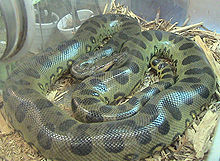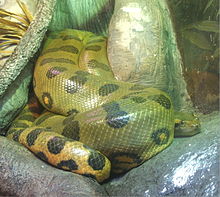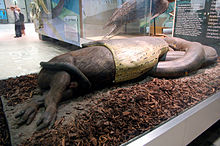- Eunectes murinus
-
Green Anaconda 
Scientific classification Kingdom: Animalia Phylum: Chordata Subphylum: Vertebrata Class: Reptilia Order: Squamata Suborder: Serpentes Family: Boidae Subfamily: Boinae Genus: Eunectes Species: E. murinus Binomial name Eunectes murinus
(Linnaeus, 1758)Synonyms [1] [Boa] murina Linnaeus, 1758
[Boa] Scytale Linnaeus, 1758
Boa gigas Latreille, 1802
Boa anacondo Daudin, 1803
Boa aquatica Wied-Neuwied, 1824
Eunectes murinus - Wagler, 1830
Eunectes murina - Gray, 1831
Eunectes murinus - Boulenger, 1893
Eunectes scytale Stull, 1935
[Eunectes murinus] murinus - Dunn & Conant, 1936
Eunectes barbouri Dunn & Conant, 1936
Eunectes murinus murinus - Dunn, 1944- Common names: Green Anaconda, Anaconda, Common Anaconda, Water Boa.
Eunectes murinus (derived from the Greek "Ευνήκτης" meaning "good swimmer" and the Latin murinus, translated into "he who predates on mice") is a non-venomous boa species found in South America. It is the heaviest known snake species. The term anaconda (without further qualification) often refers to this species, though the term could also apply to other members of the genus Eunectes.
Contents
Profile
 E. murinus, New England Aquarium
E. murinus, New England Aquarium
The Green Anaconda is one of the world's longest snakes, reaching more than 6.6 m (22 ft) long.[2] Reports of anacondas 35–40 feet or even longer also exist, but such claims need to be regarded with caution as no specimens of such lengths have ever been deposited in a museum and hard evidence is lacking.[3] There is a $50,000 cash reward for anyone that can catch an anaconda 30 ft (9.1 m) or longer, but the prize has not been claimed yet.[4] Although the reticulated python is longer, the anaconda is the heaviest snake. The longest (and heaviest) scientifically recorded specimen was a female measuring 521 cm (17 ft 1 in) long and weighing 97.5 kilograms (215 lb).[5]
The color pattern consists of olive green background overlaid with black blotches along the length of the body. The head is narrow compared to the body, usually with distinctive orange-yellow striping on either side. The eyes are set high on the head, allowing the snake to see out of the water while swimming without exposing its body.
Maximum size
The green anaconda is among the longest and most massive snakes in the world, along with the reticulated python (Python reticulatus). However, as it has inspired many wild tales of snakes ranging from large to impossibly huge, the true maximum size of this snake has remained the subject of much dispute.
Difficulties in determining maximal size
The remote location of the snake's habitat has historically made locating, capturing, and returning specimens difficult. Transporting very large specimens to museums, especially before substantial decay, is difficult (though it should be noted that this has not prevented the return of much larger and more cumbersome crocodilian specimens).[3] Skins can stretch substantially, increasing the snake's size by more than 50% if stretched during the tanning process. Reports without physical proof are considered dubious if from non-scientists, as such individuals may at worst be more interested in promoting themselves or telling a good tale, or at the least may not be sufficiently trained in proper measurement methods. Observational reports of animals which were not captured are even more dubious, as even trained scientists often substantially overestimate the size of anacondas prior to capture.[3]
Historical records
There are numerous historical accounts of green anacondas, often of ridiculously improbable sizes. Several zoologists (notably Henry Walter Bates and Alfred Russel Wallace, among others) note rumors of snakes beyond 30 or 40 feet long, but in each case note that their direct observations were limited to snakes of approximately 20 feet in length. Numerous estimates and second-hand accounts abound, but are generally considered unreliable. In one of the most reliable accounts, a geologist killed a large anaconda and measured it using a 4-meter rod, reporting it as 3 rods long (12 meters), however the information was not published until many years later, and the geologist later suggested he may have mis-remembered and the anaconda could have been only 2 rods long (8 meters). While in Colombia in 1978, herpetologist William W. Lamar had an encounter with a large female specimen which measured 24 feet 7 inches (7.5 meters) and was estimated to weigh between three and four hundred pounds.[3]
Current estimates of maximal size
Peter Pritchard considered the statistical aspects of green anaconda size, along with many other snakes of all size ranges. In many cases, maximal size was between 1.5 to 2.5 times the minimal adult length. Based on this and an estimate of 3.2 meters (10.5 feet) for minimum adult size of the green anaconda, the largest snake expected would be 8 meters long (26.3 feet). However, in the case of the reticulated python, a captive adult female was reported to have exceeded the 2.5× rule, so it should be regarded as an estimate. Furthermore, it has been suggested that most anacondas are captured from the llanos, which is more accessible to humans and has smaller prey available, while the rainforest, which is less explored and has more plentiful large prey, may be home to larger snakes.
Common names
Common names for Eunectes murinus include Green Anaconda, Anaconda, Common Anaconda and Water Boa.[6]
Local names in South America include the Spanish term mata-toro, meaning "bull killer", and the Native American terms sucuri (Tupi) and yaqumama in the Peruvian Amazon, which means "mother of the water" in the Quechua language of the jungle people Yaqurunas or "water people". In Trinidad, it has been traditionally referred to as the huille or huilla (pronounced whee-yay or whee-ya, respectively).
Geographic range
Eunectes murinus is found in South America east of the Andes, in countries including Colombia, Venezuela, the Guianas, Ecuador, Peru, Bolivia, Brazil, the island of Trinidad and as far south as northern Paraguay.[7] The type locality given is "America".[1] A small sub-population has been recorded in the Florida Everglades and this population is considered invasive.[8][not in citation given] In 2010, the state of Florida issued hunting licenses in a move to exterminate large non-native snakes recognized as a threat to the ecosystem, the green anaconda among them.[9][dead link]
Anacondas live in swamps, marshes, and slow-moving streams, mainly in the tropical rain forests of the Amazon and Orinoco basins. They are cumbersome on land, but stealthy and sleek in the water. Their eyes and nasal openings are on top of their heads, allowing them to lie in wait for prey while remaining nearly completely submerged.[10]
Behavior
The primarily nocturnal anaconda species tend to spend most of its life in or around water. Anacondas are also sometimes known as the "Water Boa"; they spend more time in water than any of the boas. Because of their large size, they appear rather slow and sluggish when traveling on land. Completely the opposite in water, however, anacondas are known to have the potential to reach high speeds in all depths of water. They tend to float atop the surface of the water with the snout barely poking out above the surface. When prey passes by or stops to drink, a hungry anaconda will snatch it with its jaws (without eating or swallowing it) and coil around it with its body. The snake will then constrict until it has successfully suffocated the prey.[11]
Feeding
Primarily aquatic, they eat a wide variety of prey, almost anything they can manage to overpower, including fish, birds, a variety of mammals, and other reptiles. Particularly large anacondas may even consume large prey such as tapir, deer, capybara and caiman, but such large meals are not regularly consumed. There are many local stories and legends regarding the anaconda as a man-eater, but there is very little evidence to support any such activity. They employ constriction to subdue their prey. Cannibalism among green anacondas is also known, most recorded cases involving a larger female consuming a smaller male. While the exact reason for this is not understood, scientists cite several possibilities, including the dramatic sexual dimorphism in the species, and the possibility that a female anaconda requires additional food intake after breeding to sustain the long period of gestation. The nearby male simply provides the opportunistic female a ready source of nutrition.[12]
Reproduction
This species is solitary until the mating season, which occurs during the rainy season, and can last for several months, usually from April to May. During this time, males must find females. Typically, female snakes will lay down a trail of pheromones for the males to follow, but it is still unclear how the males of this species track a female's scent. Another possibility is that the female releases an airborne stimulant. This theory is supported by the observation of females that remain motionless while many males move towards them from all directions. Male anacondas also frequently flick their tongues to sense chemicals that signal the presence of the female.[13]
In any case, many males often find the same female. Although it may not be necessary for there to be more than one male, this results in odd clusters, referred to as "breeding balls," in which up to 12 males wrap around the same female and attempt to copulate. The group could stay in this position from 2–4 weeks. This ball acts as a slow-motion wrestling match between the males, each one fighting for the opportunity to mate with the female.
During mating, males make use of their spurs to arouse the female. They aggressively press their cloacal regions hard against the female body while continuously scratching her with their spurs. This can produce a scratching sound. Mating approaches its climax when the stimulus of the males' spurs induce the female snake to raise her cloacal region, allowing the cloacae of the two snakes to move together. The male then coils his tail, surrounding the female and they copulate.[14] The strongest and largest male is often the victor. However, females are physically much larger and stronger and may decide to choose from among the males. Courtship and mating occur almost exclusively in water.
Mating is followed by a gestation period that lasts approximately 6–7 months. The species is ovoviviparous, with females giving birth to live young. Litters usually consists of 20–40 offspring, although as many as 100 may be produced. After giving birth, females may lose up to half their weight.
Neonates (babies) are around 70–80 cm long and receive no parental care. Because of their small size, they often fall prey to other animals. Should they survive, they grow rapidly until they reach sexual maturity in their first few years, after which their rate of growth continues at a slower pace.[11]
Captivity
Anacondas, like other snakes and most other reptiles, can quite easily adapt to a change in the climate, environment, and near surroundings when necessary. The reasons for an anaconda's needing to adapt can vary. They may need to adapt to adjust to changes in the availability of food, and any diseases they may be exposed to in new surroundings. An anaconda might also have to adjust to changes in temperature and humidity. Changes in temperature could drastically affect the snake because it is ectothermal, and relies on its environment to control its temperature. If the temperature of its surroundings increases, a snake will do everything possible to prevent its body from over-heating, and if it decreases, it will attempt to lie in heated areas to help maintain its normal temperature. Anacondas control and regulate their body temperatures by changing the amount of surface of their skin that is exposed to the sun. If the terrarium, location or "tank" where a reptile is kept, is uniformly heated producing what is known as "the greenhouse effect", then the snake could possibly die from over-heating (hyperthermia). The humidity of its surroundings might also be slightly different from the humidity to which the snake was previously accustomed. This could, potentially, drastically alter its shedding cycle. The obstruction of this cycle is extremely dangerous. The hindrance of an anaconda's shedding cycle most often causes retention of eye caps.[15] Due to these conditions and emotions of the snake, anacondas are known for their aggressive disposition when being held in captivity.[16]
Environmental requirements
One may reasonably maintain an average and acceptable temperature for the snake by the use of a heating elemant or infrared light bulbs. A gradient must be offered within the enclosure to allow the snake to bask in the heat or go to cooler areas in the tank. Optimum humidity can be difficult to maintain and research must be done on the snake to determine the correct level. Less than 80% humidity must be maintained for caging an anaconda species from the tropical region, while a slightly less than 30% humidity must be maintained for a species of a desert region.[15] Photo periods are often used with most species of snake; natural light is best for this, but Low % UV bulbs can also be used.
Subspecies
Two subspecies are recognised:[17]
In popular culture
Anacondas have been portrayed in horror literature and film, often with the ability to swallow adult humans; these traits are occasionally also attributed to other species, such as the Burmese python and the boa constrictor. Among the most popular films that feature it are the 1997 film, Anaconda, along with its three sequels Anacondas: The Hunt for the Blood Orchid, Anaconda 3: Offspring and Anacondas: Trail of Blood. This species is also the main antagonist in Mathias Bradley's novel, Anacondas: The Terror of the Amazon Rainforest, in which multiple hybrid anacondas escape from a research facility in the Amazon Rainforest and come into contact with a toxic chemical that causes them to rapidly mutate into gigantic snakes. A more positive depiction of the anaconda exists in the short stories Anaconda and El Regreso de Anaconda ("The Return of Anaconda") by Horacio Quiroga, which are told from the anaconda's point of view.
See also
- List of boine species and subspecies
- Boinae by common name
- Boinae by taxonomic synonyms
References
- ^ a b McDiarmid RW, Campbell JA, Touré T. 1999. Snake Species of the World: A Taxonomic and Geographic Reference, vol. 1. Herpetologists' League. 511 pp. ISBN 1-893777-00-6 (series). ISBN 1-893777-01-4 (volume).
- ^ Boulenger, G.A. 1893. Catalogue of the Snakes in the British Museum (Natural History), Volume I. London. p. 115.
- ^ a b c d Murphy JC, Henderson RW. 1997. Tales of Giant Snakes: A Historical Natural History of Anacondas and Pythons. Krieger Pub. Co. 221 pp. ISBN 0894649957.
- ^ Jesus A. Rivas, Rafael E. Ascanio & Maria D. C. Muñoz (2008). "What is the length of a snake?" (PDF). Contemporary Herpetology 2008 (2): 1–3. http://contemporaryherpetology.org/ch/2008/2/CH_2008_2.pdf.
- ^ Jesús Antonio Rivas (2000) (PDF). The life history of the green anaconda (Eunectes murinus), with emphasis on its reproductive Biology (Ph.D. thesis). University of Tennessee. http://www.anacondas.org/diss/disser.pdf.
- ^ Mehrtens JM. 1987. Living Snakes of the World in Color. New York: Sterling Publishers. 480 pp. ISBN 0-8069-6460-X.
- ^ ""Pescaron" una anaconda de siete metros y 90 kilos [Seven-meter-long, 90 kg anaconda "fished"]" (in Spanish). ABC Color. 4 January 2008. http://archivo.abc.com.py/2008-01-04/articulos/383544/pescaron-una-anaconda-de-siete-metros-y-90-kilos.
- ^ "Green anaconda". University of Georgia. November 18, 2009. http://www.evergladescisma.org/species/subinfo.cfm?sub=22774. Retrieved March 14, 2011.
- ^ http://www.miamiherald.com/2010/02/22/1494647/hunters-learn-how-to-catch-pythons.html
- ^ "Green Anaconda Eunectes murinus". National Geographic. http://animals.nationalgeographic.com/animals/reptiles/green-anaconda.html. Retrieved March 14, 2011.
- ^ a b Soomro, Adil (2001). "Eunectes murinus". University of Michigan Museum of Zoology (Animal Diversity Web). http://animaldiversity.ummz.umich.edu/site/accounts/information/Eunectes_murinus.html. Retrieved 2008-10-10.
- ^ Eunectes murinus (Green Anaconda): Cannibalism at Prodigy. Accessed 3 July 2008.
- ^ Burton, Maurice and Robert Burton. International Wildlife Encyclopedia, pg. 44.
- ^ Herpetologist Jesus Rivas
- ^ a b E. Fowler, Murray; Zalmir S. Cubas (2001). Biology, Medicine, and Surgery of South American Wild Animals. Blackwell Publishing. pp. 40–41. ISBN 0813828465. http://books.google.com/books?hl=en&lr=&id=jxpZo6jjFbcC&oi=fnd&pg=PA40&dq=captivity+of+anacondas&ots=1BAxWgppm4&sig=-Z0YjCJt8jSmuAuH7p4nN1BpAT8#PPA41,M1.
- ^ LLLReptile: Green Anaconda Captive Care at LLLReptile. Accessed 3 July 2008.
- ^ "Eunectes murinus (Linnaeus, 1758)". Integrated Taxonomic Information System. http://www.itis.gov/servlet/SingleRpt/SingleRpt?search_topic=TSN&search_value=634802. Retrieved 3 July 2008.
http://www.reptipro.com/care-sheets/snakes/71-green-anaconda-eunectes-murinus-care-sheet.html
Further reading
- Dirksen L, Böhme W. 1998. Studien an Anakondas 2: Zum taxonomischen Status von Eunectes murinus gigas (Latreille, 1801) (Serpentes: Boidae), mit neuen Ergebnissen zur Gattung Eunectes Wagler, 1830.- Salamandra 34(4): 359-374.
- Dirksen L. 2002. Anakondas. Monographische Revision der Gattung Eunectes (Wagler, 1830).- Natur und Tier-Verlag Münster. ISBN 3-931587-43-6. 187 pp.
External links
- Eunectes murinus (Green anaconda): Cannibalism at prodigy.net. Accessed 1 December 2008.
- Anacondas.org. Accessed 1 December 2008.
 Data related to Eunectes murinus at Wikispecies
Data related to Eunectes murinus at Wikispecies
Categories:- Boinae
- Reptiles of South America
- Megafauna of South America
- Animals described in 1758
Wikimedia Foundation. 2010.

